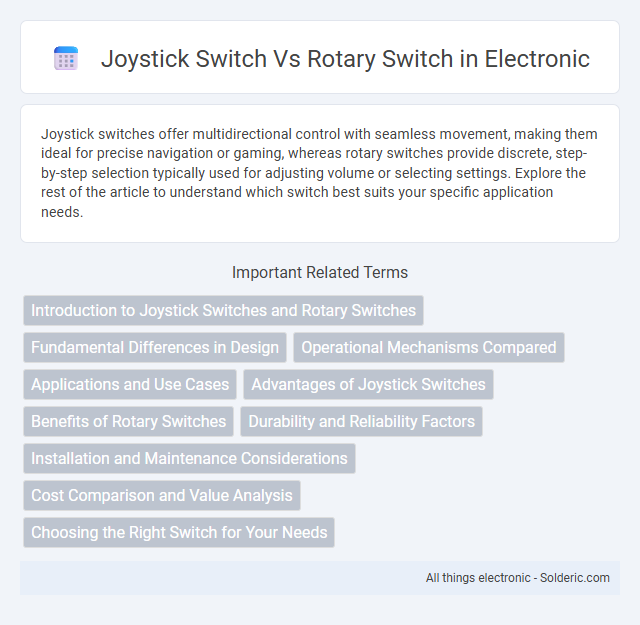Joystick switches offer multidirectional control with seamless movement, making them ideal for precise navigation or gaming, whereas rotary switches provide discrete, step-by-step selection typically used for adjusting volume or selecting settings. Explore the rest of the article to understand which switch best suits your specific application needs.
Comparison Table
| Feature | Joystick Switch | Rotary Switch |
|---|---|---|
| Function | Multi-directional control with multiple output states | Rotational control with selectable discrete positions |
| Operation | Push or tilt in various directions (X, Y axes) | Turn knob to select position |
| Applications | Gaming, robotics, remote controls | Mode selection, volume control, circuit switching |
| Contact Points | Multiple momentary or maintained contacts | Fixed number of contact positions |
| Size | Compact, ergonomic design | Varies; often larger due to mechanical parts |
| Durability | Moderate; limited mechanical wear | High; robust mechanical components |
| Cost | Generally higher due to complexity | Lower to moderate |
| Installation | Requires multi-axis mounting considerations | Simple panel or PCB mounting |
Introduction to Joystick Switches and Rotary Switches
Joystick switches provide multidirectional control by allowing movement along multiple axes, making them ideal for gaming, robotics, and industrial machinery where precise directional input is essential. Rotary switches operate by rotating a knob to select one of several electrically connected positions, commonly used in audio equipment, appliances, and instrument panels for mode or speed selection. Your choice between a joystick switch and a rotary switch depends on the need for dynamic directional control versus discrete position selection in your application.
Fundamental Differences in Design
Joystick switches feature a multidirectional stick allowing intuitive control across several axes, making them ideal for dynamic input scenarios. Rotary switches utilize a rotating contact to select circuits or settings, offering discrete, step-based control with a compact design. The fundamental design difference lies in the joystick's ability to register continuous, multidimensional movement versus the rotary switch's discrete rotational positions.
Operational Mechanisms Compared
Joystick switches operate through multi-directional lever movements that control electrical contacts, enabling dynamic input across multiple axes. Rotary switches function by rotating a knob to align fixed positions with specific contacts, offering discrete settings through sequential steps. Your choice depends on whether you need versatile control with continuous movement or precise selection via fixed positions.
Applications and Use Cases
Joystick switches are primarily used in applications requiring multi-directional control, such as gaming controllers, industrial machinery operation, and remote-controlled vehicles, offering intuitive navigation and precision. Rotary switches find extensive use in audio equipment, instrumentation panels, and household appliances where selecting different circuit paths or setting adjustable levels is essential. The choice between joystick and rotary switches depends on the need for directional input versus discrete position selection in various electronic and mechanical systems.
Advantages of Joystick Switches
Joystick switches offer precise multi-directional control, making them ideal for applications requiring nuanced input such as gaming consoles, industrial equipment, and robotic systems. Their ergonomic design enhances user comfort and reduces fatigue during extended use, improving overall operational efficiency. You benefit from faster response times and intuitive control compared to rotary switches, which typically allow only rotational movement limited to specific detents.
Benefits of Rotary Switches
Rotary switches offer precise multi-position control, making them ideal for selecting different circuit paths or settings with minimal space requirements. Their durable construction ensures long-term reliability in industrial applications where frequent switching is necessary. Choosing a rotary switch enhances your device's functionality by enabling seamless operation across multiple modes with reliable tactile feedback.
Durability and Reliability Factors
Joystick switches exhibit higher durability due to their robust design, accommodating multidirectional inputs and frequent usage in industrial applications. Rotary switches provide reliable performance with distinct detent positions, but their mechanical complexity may lead to faster wear under continuous or harsh conditions. Material quality, construction standards, and environmental resistance significantly influence the long-term reliability of both switch types.
Installation and Maintenance Considerations
Joystick switches typically require more complex installation due to multiple wiring connections and precise alignment, while rotary switches tend to have simpler wiring with fewer terminals. Maintenance for joystick switches can be more demanding because of moving parts that are prone to wear and require regular lubrication, whereas rotary switches generally offer easier upkeep with fewer mechanical components. Your choice should consider the installation complexity and the frequency of maintenance to ensure long-term operational reliability.
Cost Comparison and Value Analysis
Joystick switches generally have a higher initial cost compared to rotary switches due to their complex design and multifunctional capabilities. Rotary switches offer a more budget-friendly option with simpler mechanics, making them ideal for applications requiring basic directional input. Your choice should weigh the joystick's advanced control benefits against the rotary switch's cost efficiency and durability for long-term value.
Choosing the Right Switch for Your Needs
Selecting the right switch depends on the specific application and user interaction required. Joystick switches offer multidirectional control, making them ideal for navigational tasks and gaming devices, while rotary switches provide precise, step-based selection for settings like volume control and mode selection. Consider the complexity of input, installation space, and durability to determine whether a joystick or rotary switch best suits your device.
joystick switch vs rotary switch Infographic

 solderic.com
solderic.com